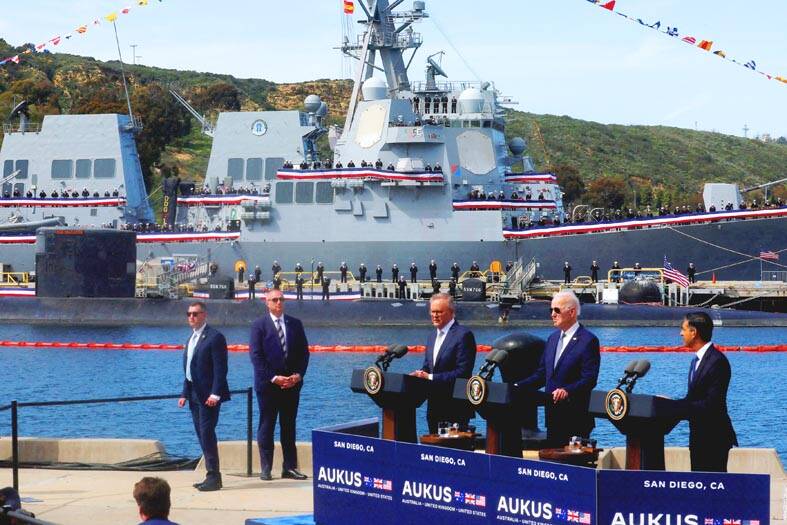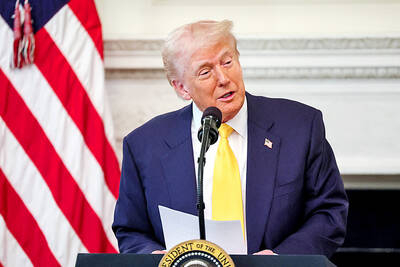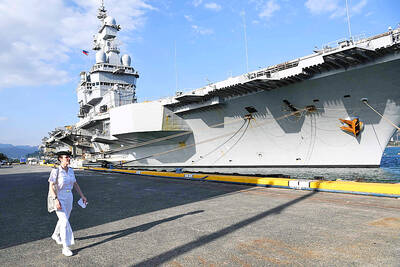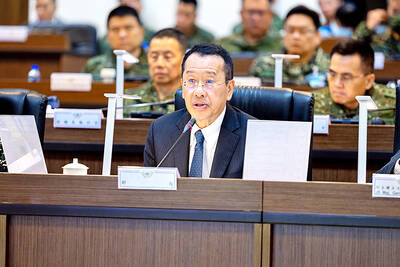Australia is confident that the US would follow through with the sale of nuclear-powered submarines as part of the AUKUS deal, Australian Minister for Defence Industry Pat Conroy said yesterday, after mooted cuts to the US program sparked concerns that deliveries could be delayed or scrapped.
Under the AUKUS partnership signed in 2021, the US is to sell Australia three to five Virginia-class attack submarines from the early 2030s as a stopgap while Australia and Britain build a new SSN-AUKUS class due about a decade later.
Fears that backlogs at US shipyards and a shrinking submarine fleet could undercut willingness for the sales boiled over this week when the administration of US President Joe Biden cut its funding request for the Virginia class.

Photo: Reuters
Conroy said that Australia had total confidence in the AUKUS deal and that the US was making good progress upgrading its shipyards so they could produce the Virginia class for both navies.
“I see a lot of hyperbolic headlines about the death of AUKUS. I think it’s the fourth time AUKUS has died in the last year,” he told reporters by telephone. “We remain very confident that we’ll be in a position for the Virginia class to be sold to Australia on the timeframes articulated.”
The US Navy is building an average of slightly more than one Virginia-class submarine a year, well short of the estimated 2.33 needed to grow its fleet and sell boats to Canberra.
At a budget briefing on Monday, US Undersecretary of the Navy Erik Raven said that the submarine industrial base was stressed, but an US$11.1 billion, five-year investment in the budget request plus a promised US$3 billion from Australia as part of AUKUS would lift production to target.
However, by the time the sales near in 2030, the number of attack submarines in the US Navy is set to fall to a historic low of 46 versus a target of 66, said Michael Shoebridge, founder of Strategic Analysis Australia and a former defense official.
“It’s going to get harder for a commander of the US submarine force to say: ‘No, I can get by with less submarines, I’m happy to sell three to my Australian friends,’” Shoebridge said. “A US president will come under more pressure to say: ‘I need to look after my own security first.’”
Former Australian prime minister Malcolm Turnbull said that the US was unlikely to make its own deficit worse by sending submarines to Australia.
“This is really a case of us being mugged by reality,” he told Australian Broadcasting Corp.

STILL COMMITTED: The US opposes any forced change to the ‘status quo’ in the Strait, but also does not seek conflict, US Secretary of State Marco Rubio said US President Donald Trump’s administration released US$5.3 billion in previously frozen foreign aid, including US$870 million in security exemptions for programs in Taiwan, a list of exemptions reviewed by Reuters showed. Trump ordered a 90-day pause on foreign aid shortly after taking office on Jan. 20, halting funding for everything from programs that fight starvation and deadly diseases to providing shelters for millions of displaced people across the globe. US Secretary of State Marco Rubio, who has said that all foreign assistance must align with Trump’s “America First” priorities, issued waivers late last month on military aid to Israel and Egypt, the

‘UNITED FRONT’ FRONTS: Barring contact with Huaqiao and Jinan universities is needed to stop China targeting Taiwanese students, the education minister said Taiwan has blacklisted two Chinese universities from conducting academic exchange programs in the nation after reports that the institutes are arms of Beijing’s United Front Work Department, Minister of Education Cheng Ying-yao (鄭英耀) said in an exclusive interview with the Chinese-language Liberty Times (the Taipei Times’ sister paper) published yesterday. China’s Huaqiao University in Xiamen and Quanzhou, as well as Jinan University in Guangzhou, which have 600 and 1,500 Taiwanese on their rolls respectively, are under direct control of the Chinese government’s political warfare branch, Cheng said, citing reports by national security officials. A comprehensive ban on Taiwanese institutions collaborating or

France’s nuclear-powered aircraft carrier and accompanying warships were in the Philippines yesterday after holding combat drills with Philippine forces in the disputed South China Sea in a show of firepower that would likely antagonize China. The Charles de Gaulle on Friday docked at Subic Bay, a former US naval base northwest of Manila, for a break after more than two months of deployment in the Indo-Pacific region. The French carrier engaged with security allies for contingency readiness and to promote regional security, including with Philippine forces, navy ships and fighter jets. They held anti-submarine warfare drills and aerial combat training on Friday in

COMBAT READINESS: The military is reviewing weaponry, personnel resources, and mobilization and recovery forces to adjust defense strategies, the defense minister said The military has released a photograph of Minister of National Defense Wellington Koo (顧立雄) appearing to sit beside a US general during the annual Han Kuang military exercises on Friday last week in a historic first. In the photo, Koo, who was presiding over the drills with high-level officers, appears to be sitting next to US Marine Corps Major General Jay Bargeron, the director of strategic planning and policy of the US Indo-Pacific Command, although only Bargeron’s name tag is visible in the seat as “J5 Maj General.” It is the first time the military has released a photo of an active